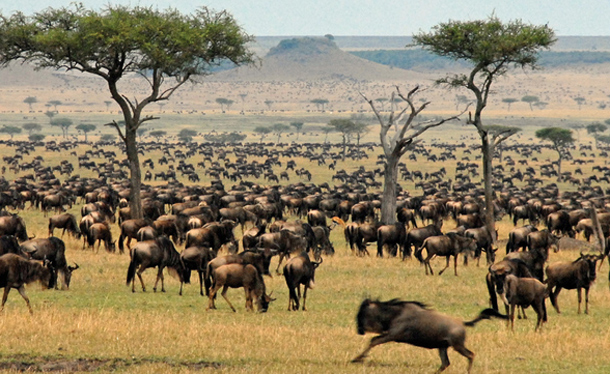It is an understatement to say that there is no other kind of antelope all over the place which could top the wildebeest. Well, why not? Upon looking at it, one would assume that it has been assembled out of spare parts. Start from its forequarters, they look as if they originated from ox. The hindquarters on the other hand might have been derived from antelope. As for their tail and mane, they are synonymous to that of a horse. A tenfold of wildebeest facts would agree that their name might have been earned from their antics as territorial bulls.
What else to know about the species?
Wildebeests are species which are capable of forming large herds. These are true as far as Seregentis-Mara of the ecosystem is concerned. This is how it has been witnessed in Kenya and Tanzania. These are popularly considered as brindled. They are often seen as blue- or even white-bearded gnu. There are scientists who are responsible for making a distinction between these animals. They also enlisted the blue as a distinguished race. This is set to be seen in Tanzania. Furthermore, the wildebeest is also described as a white-bearded whenever it is seen in northern Tanzania and southern Kenya.

The attributes
The wildebeest goes with a head which is box-like and large. There are males and females which are equipped with curving horns. These are closed together in their base. They are also curve outward and inward, and then slightly at the back. As for their body, it appears to be disproportionate. This create that sort of impression since their front end is designed on a really heavy and rigid manner. Their hindquarters do not suit the earlier because they are really slender. As for their legs, they are spindly. These are enough to say that they do not look so proportionate at all.
Usually, these wildebeests are found in the acacia and plains of eastern Africa. This is perceived to be their habitat.
The behavior of wildebeest is somehow predictable. For each year, they are expected to undergo a migratory circle. This is going to take around 500 to 1,000 miles. In here, the migration begins after the calving season occurs. This is around January to February. They would normally do this through the short grass plains. This is easily found at southeastern Serengeti. Afterwards, the Wildbeests may also move towards the west Lake Victoria. They would do this just across the savanna grass directly to the open woodlands. Then, they are going to north just in the Mara. They would then return to the south after this destination. Needless to say, they are very much relentless when it comes to advancing. There are even instances when they would swim lakes and rivers. They would also do the same with huge masses. This is why some of them can get injured sometimes. Others may be lost. There are those which can also be killed.
Wildebeest continually moves to. This is a chance for a favorable supply of water and grass to be sought for.